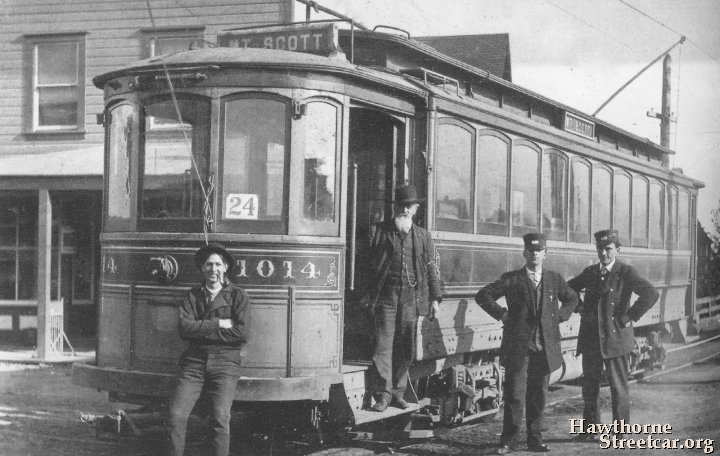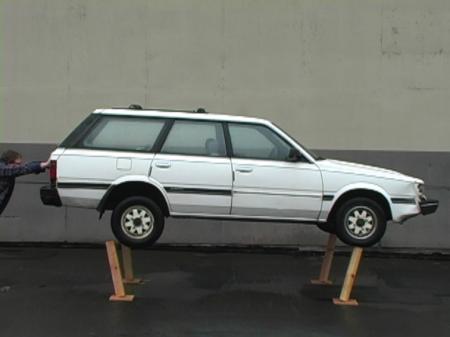
|
||
|
Portland art blog + news + exhibition reviews + galleries + contemporary northwest art
|
||
In preparation for Jesse Sugarmann's "Lido (The Pride Is Back)" at TBA
There was a time when trolley cars and electric trains ruled the cityscape. Then, with the help of Standard Oil, Firestone Tire and other companies, General Motors went on a buying spree to purchase many of those transit systems and replace them with their own buses. To compete with Ford's Model T, GM bought up a lot of other car manufacturers (including making an early bid for Ford) in order to offer a variety of models and colors. So, when given the choice between riding in something crowded and stinky or something roomy, shiny and speedy, what followed (if not in as a direct line as this brief synopsis indicates) was our fascination with all things cars. Granted, GM didn't manage this feat of cultural obsession single-handedly. Cars were more freeing, and, one might argue, with that freedom came a greater sense of the individual, a little of the ramblin' man and the competitive spirit rolled into one. Ad campaigns fueled the perceived need for this luxury, and continue to do so: An attractive woman sits close to her man, the rag-top down, the wind almost non-existent heading down the highway, and both smiling as if they shared the secret of perfect joy. Or, consider the family of seven on their way to Yosemite in a station wagon. Even their dog is having a good time. Selling a dream, they are. An illusion we jump through substantial financial hoops to embrace. What we have instead is a love/hate relationship with our cars, perhaps because the reality runs so contrary to the promise. Instead of liberation, we remain largely dependent on these vehicles. The ads don’t sell the planned obsolescence, just the newest styles; nor do they show the fights over that extra inch of the back seat between three preteens confined for 230 miles with no toilet break and the consequent threats from the driver to pull over. Well, if a bush is nearby after the whippin' ...
Threats to domestic bliss and the potential for worse outcomes lay just under the surface in Jesse Sugarmann's art. The first clue we have is "Subaru Wreck," in which he pushes said make of car off of the tall wood blocks on which it is precariously balanced. The video begins with the car up on the blocks, when suddenly Sugarmann enters the frame and gives the car a hefty shove. A more reflective sort of violence is seen in his video, "One of These Nights." I'm not going to ruin it for interested readers. Go to jessesugrmann.com and watch it. And while you're there, check out "I'm on Fire," a transitional piece from his early work. Sugarmann is one of the poster kids this year for Portland Institute of Contemporary Art;s Time-Based Art Festival. Featured in the press materials is a still from his 2009 video, "Voyager Union." An older Voyager minivan has its backend propped up by pieces of lumber so that the van’s front bumper is touching the ground. The image calls to mind a performer on stilts, and even though in the video the inevitable occurs, it is in the still image where the tenuousness of the moment is most keenly felt. It’s all going to come crashing down, and we want to watch. Automobiles are so much a part of our every day life that many of the associations and issues surrounding their impact and place in our lives, when brought to and imbued with meaning through an art practice, can readily fall victim to cliché or be overly pedantic. Sugarmann's earlier pieces come dangerously close when he addresses the environmental impact (the "Fresh Aire" series) of car exhaust and makes the fumes more real for us. However, his performances are done with a mix of futility and humor (at one point a cop approaches and asks what, exactly, he is doing), and therefore are more like tragicomedy.
Anticipation is key to much of Sugarmann's videotaped performance pieces, and therefore they require patience for the promised calamity. Yet, while destruction is often the end result with his earlier work, his more recent series, "Silver Anniversary" (exhibited in early summer at Fourteen30 Contemporary) are more subdued. The "stunts" are more choreographed, more like a dance than a demolition derby. As in many of Sugarmann's earlier works, the vans are close to identical, calling to mind Ford’s assembly-line efficiency. Yet, the sameness allows for certain symmetry that enhances the performance and its overall meaning. In "Silver Anniversary #3" the rear end of a white minivan is sitting on a flatbed truck with the front end sharply angled toward the ground. Sugarmann uses a forklift to bring another van into the picture. Perched on the tines at an angle this van perfectly aligns, rear end to rear end, with the other, and the two vans thereby create a diagonal trajectory. Nothing more happens until near the end of the video when the forklift backs up, taking its van with it. No crash. In "#4" we see the same van positioned the same way again on the flatbed. This time the van on the forklift is lifted high enough for Sugarmann to pull up to the front bumper of the van on the ground. By simultaneously backing up and lowering the van via the tines, he is able to roll its back tires down the roof of the bottom van. In his second approach, he places the wheels on the front of the hood and rolls the tires to the back. Neither pass is perfect, yet again, no crash. There is instead a sort of simple yet practiced elegance. It is only after reading the subtitles for these two works that we receive a jolt, for one is dedicated to S. Christa McAuliffe and the other to Judith Resnik, both astronauts who died in the Challenger explosion in 1986. The collision occurs between Sugarmann's graceful maneuvers and the televised, arching image of the tragedy that lives on in our collective mind. Sugarmann is quite capable of subverting our expectations, and he can also be content to let a certain degree of chaos create its own spectacle. Just as "The Allure of the Automobile" is winding down at the Portland Art Museum, Sugarmann is presenting "Lido (The Pride Is Back) for TBA. An expanded version of his "Red Storm Rising," "Lido" consists of three Chrysler minivans parked upon forty-two air mattresses (fourteen for each). The mattresses will be simultaneously inflated, lifting the vans to a somewhat uncertain fate while also creating monuments of/to the vans. I have not nearly enough addressed the sculptural aspects of Sugarmann's work, when, in fact, he has a fairly large body of themed work that does not rely on video or performance. While a piece like "Dad Effigy" is certainly emotive, it elicits empathy, which is quite different from the vicarious thrill of his kinetic works. One gets the sense that Sugarmann is aware of this impulse for the thrill, which might be one reason much of his more recent works subvert our wanton desire for destruction. After working with automobiles and auto parts for several years now, I wonder if Sugarmann might be nearing the time when the trope of the car becomes exhausted. Perhaps not, for as his homage to dead astronauts has shown, so much of our psyche is tied into travel, discovery, speed, design, and heck, with a nod to J.G Ballard and drive-in movies, even sex. His journey may have just begun. Posted by Patrick Collier on September 07, 2011 at 22:17 | Comments (0) Comments Post a comment Thanks for signing in, . Now you can comment. (sign out)
(If you haven't left a comment here before, you may need to be approved by
the site owner before your comment will appear. Until then, it won't appear
on the entry. Thanks for waiting.)
|
| s p o n s o r s |
 |
 |
 |
 |
 |
 |
 |
 |
 |
 |
 |
 |
 |
 |
 |
 |

|
Site Design: Jennifer Armbrust | • | Site Development: Philippe Blanc & Katherine Bovee | |




